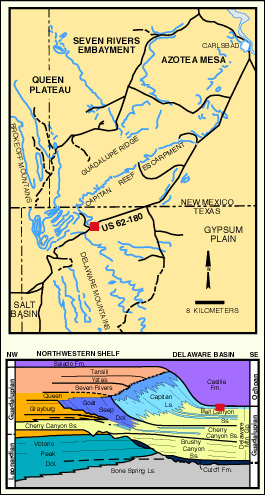
Permian Reef Complex Virtual Field Trip
Stop II-6: Lamar Limestone – Basinal Shaly Carbonate Rock

BE CAREFUL TRAFFIC IS ESPECIALLY HAZARDOUS AT THIS OUTCROP!

© Peter A. Scholle, 1999
This section exposes basinal, black, laminated limestones and shales (see photo) of the Lamar Limestone Member, the youngest named member of the Bell Canyon Formation. Some features indicative of turbidite deposition of platform-derived, fine-grained carbonate sediment can also be seen (micro-grading, reworked fragments of shelf and slope fossil such as Tubiphytes). The Lamar is sparsely fossiliferous at this locality, with some fusulinids (including Yabeina), small ammonoids, brachiopods and other groups.

© Peter A. Scholle, 1999
The Lamar Limestone becomes darker and more organic carbon-rich toward the basin center; indeed, all benthic organisms are absent from these basin-center sediments. Conversely, the unit becomes lighter colored and more fossiliferous toward the basin margin. It seems, therefore, that euxinic conditions were largely restricted to the deepest parts of the Delaware basin (Babcock, 1977). In this area, relatively near the basin margin, a moderately diverse fauna which includes burrowing pelecypods, siliceous sponges, holothurians, and conodonts, is evidence that conditions here were not uniformly anaerobic (Babcock, 1977). Yet the evaporite crystal casts found on many bedding surfaces (see photo), the organic carbon-rich sediment, and the widespread preservation of very fine-scale lamination all indicate that largely dysaerobic, evaporitic bottom waters occupied this region during much of Lamar time. Presumably, poorly oxygenated conditions were periodically relieved by input of turbidity currents bringing sediment-laden, oxygenated waters down-slope into the basin. These events were probably accompanied by short-lived but widespread colonization of the basin floor by benthic organisms.
Submarine mass movements are also indicated by the large-scale contortions and thickness variations seen in many of the beds, as such structures are characteristic of synsedimentary slides and slumps. Brown and Loucks (1988, p. 10) have interpreted even larger-scale features at this outcrop as the base of a very large debris slide which occupies the entire upper part of the outcrop.
The lateral thickness variations of the Lamar Ls. follow a familiar pattern of basin-margin to basin-center change. The Lamar thins from 90 m (300 ft) along the Capitan slope, to approximately 6-9 m (20-30 ft) in this area (about 7.2 km or 4.5 mi from the shelf margin), to as little as 2 m (6 ft) in outcrops about 27 km (17 mi) from the basin edge, and eventually to less than a meter (ca. 2 ft.) of silty shale in subsurface sections near the basin center (Babcock, 1977; Tyrrell, 1969).
The Lamar Mbr. is the youngest limestone unit in the Guadalupian part of the Delaware basin. As such, it is a lateral facies equivalent of the uppermost part of the Capitan Limestone on the shelf edge, and the Tansill Formation in back-reef, shelf-interior areas. A thin sandstone occurs between the clearly Guadalupian Lamar Limestone and the overlying Ochoan Castile Formation. Its exact stratigraphic affinities are still somewhat unclear (see, for example Reid et al., 1988 and Wilde and Rudine, 1996) although Wilde et al. (1999) have recently provided a formal designation for the "post-Lamar beds" as the "Reef Trail Member of the upper Bell Canyon Formation."


